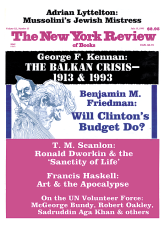In response to:
The Iran-Contra Secrets from the May 27, 1993 issue
To the Editors:
Theodore Draper’s review of George P. Shultz’s Turmoil and Triumph [“The Iran-Contra Secrets,” NYR, May 27] is based on a fundamental misunderstanding of the book. Draper charges that Shultz’s account is “hopelessly distorted” and “untrustworthy” because, for example, it attributes a document in the affair to Mr. Cave rather than Mr. Hakim. What Draper surely would have understood had he read the book from the beginning rather than just the Iran-Contra chapter, is that Shultz confines his narrative to what he knew or was told at the time and excludes information and evidence which came to light after a decision or event occurred. This makes Turmoil and Triumph a unique, irreplaceable and unchallengeable historical document, as it reveals a reality that “memoirs” invariably obscure: decisions of statecraft must be taken on the basis of partial and sometimes erroneous reports. Thus it may be true that Hakim, not Cave, was the 9-point drafter, but Shultz at the time was told it was Cave, and to be true to how things actually were, Shultz’s narrative must say “Cave.” The remarkable revelation of Shultz’s book is that the arms-for-hostages-for-funds for Contras scheme continued even after the stunning public revelations of November 1986. If Shultz had resigned or been fired, he would have lost the political base from which he fought to get the scheme stopped.
In this review, as in so many of his analyses of policy controversies, Draper reads every note, but never seems able to hear the music.
Charles Hill
New Haven, Connecticut
Theodore Draper replies:
Charles Hill, the former executive assistant of former Secretary State George Shultz, has not done Shultz a favor.
The real issue is simple. Is Shultz’s book a farrago of “what he knew or was told at the time” or is it a trustworthy record of what actually happened? These are two different things, and they should not be confused. Whatever Shultz may have been told at the time, the reader has a right to know what actually happened and not merely what Shultz thought at the time had happened.
In fact, Shultz gives every evidence of wanting the reader to believe he is getting a straightforward, trustworthy account that can stand up to historical scrutiny. If not, Shultz has produced 1,138 pages of dubious value as a reliable record of what actually happened rather than what he may have thought had happened.
Of all the points I raised about Shultz’s treatment of the arms-for-hostages deals, Hill chooses to make a test case of the reference to Cave, whom Shultz mistakenly made the drafter of the nine-point program. Hill writes: “Thus it may be true that Hakim, not Cave, was the 9-point drafter, but Shultz at the time was told it was Cave, and to be true to how things actually were, Shultz’s narrative must say ‘Cave.’ ”
This is a peculiar interpretation of “how things actually were.” Hakim was the nine-point drafter, so that is how “things actually were.” Shultz was told at the time that it was Cave, so that was how things actually were not.
But even if we accept the strange premise that Shultz had to put in his book only what he was told at the time, however erroneous in fact, a question arises: Was not Shultz obliged to tell the reader what the truth was? If Hakim, not Cave, proved to be the drafter of the nine-point program, should Shultz not have made it clear to the reader?
Shultz did not have to mangle this story. He could have consulted the memorandum of his own man, Charles Dunbar, which clearly stated that there was no negotiation after November 1986; there was nothing more than a meeting in Frankfurt at which Dunbar had quickly rebuffed the Iranian emissary. Shultz could also have consulted Cave’s testimony which explained that he had merely received a message from the Iranian and sent it off to Washington, with no semblance of a negotiation. Or if this documentary evidence was too much for him, he could have consulted my book, A Very Thin Line, pages 553–555, where the facts as given by Dunbar and Cave were conveniently laid out for him. Yet Shultz’s account is full of righteous indignation and self-congratulation on the mistaken assumption that there was a serious negotiation against which he fought another of his mythical “battles.”
As for notes and music, the music cannot be right if the notes are wrong.
This Issue
July 15, 1993



